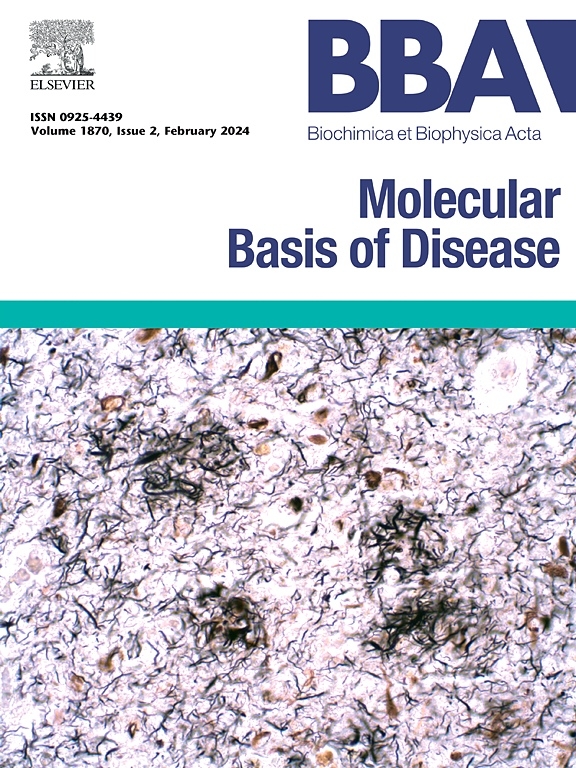幽门螺杆菌酪氨酸磷酸化的CagA EPIYA-D基序增强宿主Grb2的募集,促进细胞的致癌转化
IF 4.2
2区 生物学
Q2 BIOCHEMISTRY & MOLECULAR BIOLOGY
Biochimica et biophysica acta. Molecular basis of disease
Pub Date : 2025-08-15
DOI:10.1016/j.bbadis.2025.168018
引用次数: 0
摘要
CagA是幽门螺杆菌的关键毒力因子之一,在幽门螺杆菌相关胃癌中发挥重要作用,积极参与肿瘤转化。在CagA变体中,携带EPIYA-D基序的东亚型CagA (CagAE)比携带EPIYA-C基序的西方型CagA (CagAW)具有更高的风险。在这项研究中,我们研究了CagAE和CagAW与宿主细胞内Grb2的相互作用,发现与CagAW相比,CagAE对Grb2的募集明显更多。我们的研究结果表明EPIYA基序中的磷酸化酪氨酸对于CagA与Grb2的结合非常重要。epyya - d中Y + 5位置的Phe与Grb2的SH2结构域Trp121相互作用,建立了比epyya - c与Grb2-SH2相互作用更高的亲和力。在CagAE EPIYA-D中,用Phe代替Asp/Ala减少了CagAE对Grb2的募集,并中和了受体细胞较强的诱导恶性特性。这些发现为CagAE和CagAW所采用的独特调节机制提供了额外的见解,有助于更好地理解与幽门螺杆菌CagAE相关的较高致癌风险。本文章由计算机程序翻译,如有差异,请以英文原文为准。

Augmented recruitment of host Grb2 by Helicobacter pylori tyrosine phosphorylated CagA EPIYA-D motif promotes cellular oncogenic transformation
CagA, one of the key virulence factors of Helicobacter pylori, plays a significant role in H. pylori-associated gastric cancer by actively participating in neoplastic transformation. Among CagA variants, East Asian type CagA (CagAE) bearing the EPIYA-D motif exhibits a higher risk than the Western-type (CagAW) with EPIYA-C motifs. In this study, we investigated the interactions of CagAE and CagAW and host intracellular Grb2 and found a pronouncedly greater recruitment of Grb2 by CagAE compared to CagAW. Our findings revealed the phosphorylated tyrosine in the EPIYA motif is very important for the binding of CagA to Grb2. Phe at Y + 5 position in EPIYA-D, which interacts with Trp121 in SH2 domain of Grb2, established the higher affinity than the interaction of EPIYA-C and Grb2-SH2. The substitute of Phe to Asp/Ala in CagAE EPIYA-D reduced the recruitment of Grb2 by CagAE, and neutralized the stronger induced malignant characteristics of the recipient cells. These findings provide additional insights into the distinct regulatory mechanisms employed by CagAE and CagAW, contributing to a better understanding of the higher oncogenic risk associated with H. pylori CagAE.
求助全文
通过发布文献求助,成功后即可免费获取论文全文。
去求助
来源期刊
CiteScore
12.30
自引率
0.00%
发文量
218
审稿时长
32 days
期刊介绍:
BBA Molecular Basis of Disease addresses the biochemistry and molecular genetics of disease processes and models of human disease. This journal covers aspects of aging, cancer, metabolic-, neurological-, and immunological-based disease. Manuscripts focused on using animal models to elucidate biochemical and mechanistic insight in each of these conditions, are particularly encouraged. Manuscripts should emphasize the underlying mechanisms of disease pathways and provide novel contributions to the understanding and/or treatment of these disorders. Highly descriptive and method development submissions may be declined without full review. The submission of uninvited reviews to BBA - Molecular Basis of Disease is strongly discouraged, and any such uninvited review should be accompanied by a coverletter outlining the compelling reasons why the review should be considered.

 求助内容:
求助内容: 应助结果提醒方式:
应助结果提醒方式:


